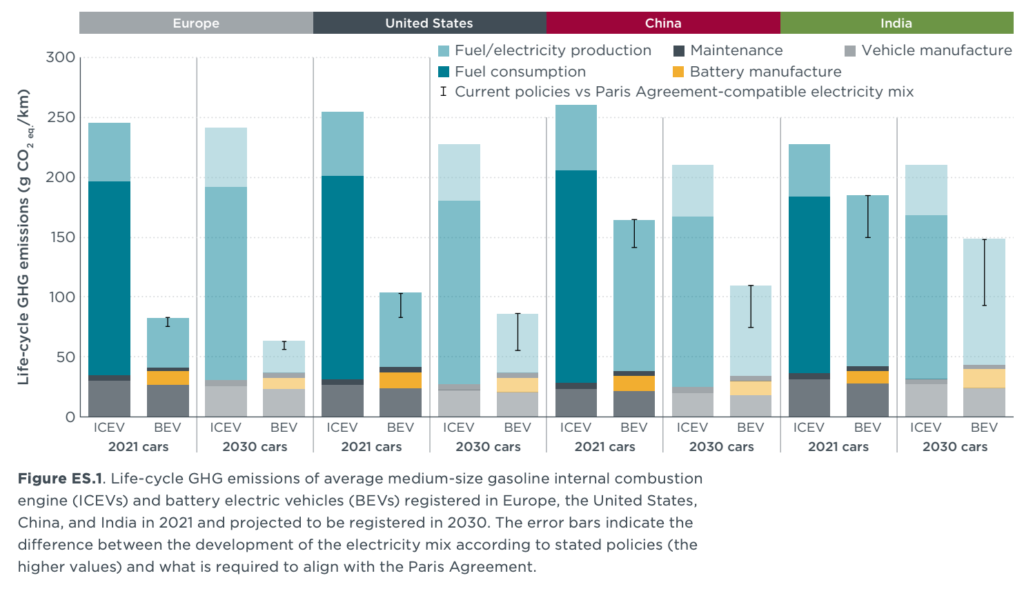The short answer is Yes. Let’s take a look at why.
At the very end of 2021, we posted a video called “Ask Nick Anything” where our Executive Director, Nick Hylla, answered questions we had gathered over the preceding few weeks. (If you haven’t seen it, I encourage you to check it out.) One of the questions was: Is it possible to find lifetime analyses of electric cars, windmills, or solar panels that compares greenhouse gas emissions to fossil fuel electrical energy or internal combustion cars? His answer in general is yes, but, especially as it pertains to electric vehicles, it will depend on where you plug in. In other words, the mix of electricity generation sources on the grid differs from place to place, with some being more fossil fuel-intensive than others.
I wanted to expand on this a little further and point readers in the direction of analyses that have been done comparing traditional technologies (read: fossil fuels, internal combustion engines) against newer technologies.
First, what is lifecycle assessment? To compare technologies’ greenhouse gas emissions (GHG), various methodologies are used to account for all the greenhouse gases emitted during the upstream, operations, and downstream phases of the technology. “Upstream” refers to the extraction of resources, manufacturing processes, and construction of the technology. “Operations” are essentially the period of the technology being in use. “Downstream” refers to the decommissioning, disposal, and/or recycling processes when the technology is no longer in use. Because certain technologies like solar PV and nuclear have more greenhouse gas emissions during their upstream phases (like mining and transporting silicon or uranium), and technologies like fossil fuels produce more greenhouse gases during operation (the burning of coal), an accurate comparison takes account of all greenhouse gases throughout that entire lifecycle.
The National Renewable Energy Laboratory (NREL) has put together a quite useful meta-analysis of 3,000 studies, vetting the quality of them to such an extent that 85% of studies’ results were not deemed up to par. In their words: “A systematic review, comprising three rounds of screening by multiple experts, selected references that meet strict criteria for quality, relevance, and transparency.”
As NREL demonstrates, renewables like wind energy, ocean energy, hydropower, and to a somewhat lesser extent PV, concentrated solar power, and geothermal, each outperform natural gas, coal, and oil in terms of lifecycle GHG. (Notably, renewable biopower has an incredible range of greenhouse gas emissions estimates, but the median half of outcomes is still much better than fossil fuels.) The chart below summarizes their findings.

Life cycle greenhouse gas emission estimates for selected electricity generation and storage technologies, and some technologies integrated with carbon capture and storage (CCS). (Figure courtesy of National Renewable Energy Laboratory)
Despite all the industry messaging around natural gas as a clean alternative to coal and oil, you can see that lifecycle GHG resulting from natural gas is still far more significant than renewable energy lifecycle GHG.
Let’s turn our attention to vehicles, and analyses performed by the International Council on Clean Transportation (ICCT). The ICCT famously blew the whistle on Volkswagen’s diesel car emissions in 2014.
According to ICCT, “The life-cycle GHG emissions of U.S. average BEVs registered in 2021 are 57%–68% lower than for comparable average gasoline vehicles.”
To reinforce Nick’s answer to the question on “Ask Nick Anything” that I mentioned above, they added: “It is notable that these numbers correspond to the carbon intensity of the national average U.S. grid; in states like California, where the carbon intensity of electricity is below the national average, the life-cycle GHG emissions of BEVs would also be lower.”

(Figure courtesy of ICCT)
You may be wondering how hybrid vehicles stack up in this comparison. Below is a chart demonstrating conventional internal combustion engine vehicles against hybrids and batteries. The graph on the left is “lower medium” sized vehicles and the right side is SUVs. These assessments are for the European market but should be roughly indicative of US vehicles as well.

(Figure courtesy of ICCT)
A few other points of interest from the ICCT’s study:
- Life-cycle GHG emissions of gasoline and diesel cars are twice as high as official tailpipe CO2 values
- Hybrids correspond to 20% lower life-cycle GHG emissions than conventional cars
- In real-world usage, Plug-in Hybrids show 25%–31% lower life-cycle GHG emissions than gasoline cars
- Battery Electric Vehicles have 63%–69% lower life-cycle GHG emissions than gasoline cars, and vary with the electricity mix
- Renewables-powered Battery Electric Vehicles and Fuel Cell Electric Vehicles show 76%–81% lower emissions than gasoline cars
- When considering a continuously decreasing carbon intensity of the electricity mix in the coming years, the GHG emissions benefit of Battery Electric Vehicles grows for future cars.
In sum, you can minimize the greenhouse gas emissions of your home and vehicle by putting solar on your property, and in turn powering your electric vehicle with your solar array. I’ll leave you with a reminder that the current transportation system is incredibly wasteful: in the US in 2020, 19.2 quads5 of energy was wasted out of the total 24.3 quads of energy used for transportation – 79%.

(Figure courtesy of Lawrence Livermore National Laboratory)
For environmental and economic reasons alike, we should do whatever we can to minimize waste in this system, and choosing technologies with lower GHG is one way to do that.
Plus, as we say here at MREA… “PV + EV = Driving on Sunshine.”
Citations:
- https://www.nrel.gov/docs/fy21osti/80580.pdf
- https://www.youtube.com/watch?v=eJygrETqydw
- https://theicct.org/sites/default/files/publications/Global-LCA-passenger-cars-jul2021_0.pdf
- https://flowcharts.llnl.gov
- A quad is a unit of energy equal to 1 quadrillion (1015) British thermal units (BTUs). The quad is a convenient unit for describing national and world energy resources. One quad is also equal to 293 billion kilowatt-hours or, for fuels of average heating values, the energy of 183 million barrels of petroleum, 38.5 million tons of coal, or 980 billion cubic feet of natural gas. https://www.britannica.com/science/quad


